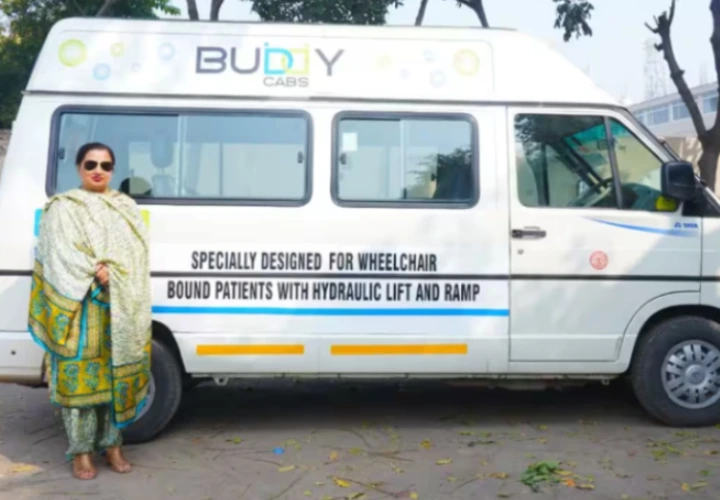Improving Mobility and Independence: The Importance of Wheelchair Accessible Taxis in Punjab
Introduction
Mobility is freedom. The ability to move around independently is essential for disabled individuals to fully participate in society. For many people with disabilities, especially those with mobility impairments, transportation poses a major challenge. While public infrastructure and transport facilities have improved accessibility over the years, significant gaps remain. This is where taxis play a vital role in enhancing the mobility and independence of disabled residents in Punjab.
As per India’s 2011 census, over 2.68 crore people in India have a disability. This amounts to 2.21% of the population. In Punjab alone, 5.10 lakh individuals are living with disabilities, the majority of them having restricted mobility. For these individuals, taxis are often the most convenient and dignified mode of point-to-point travel. Taxis provide them the flexibility to travel when needed along routes and schedules that work for their requirements.
Unlike buses or trains, taxis can be made wheelchair-friendly relatively easily. By installing ramps or lifts, sufficient space for wheelchairs, and anchorage systems for secure wheelchair locking, taxis can be customized for barrier-free access. Such wheelchair-accessible taxis have emerged as an affordable and comfortable taxi for the disabled in Punjab.
Legislative Push for Accessible Transportation
The Rights of Persons with Disabilities Act of 2016 mandates equal opportunities for disabled persons, including in transportation facilities. It places obligations on authorities to provide accessible modes of transportation. The Punjab State Transport Department has also taken steps to improve accessibility, such as issuing permits for wheelchair-friendly taxis and awareness drives for taxi operators. However, more needs to be done to expand and streamline accessible taxi services.
Understanding User Requirements
To enhance taxi services for the disabled, the needs and perspectives of users must be considered. As per a survey by Aime Mobility, over 90% of respondents faced difficulties using public transport. They desired greater availability of accessible taxis along with trained drivers. Users also recommended improvements like app-based bookings and incentivizing taxi owners to adopt disabled-friendly vehicles through subsidies.
Incorporating such inputs to make taxis more convenient, affordable, and dignified should be the cornerstone of any policy or initiative aimed at the disabled population. Their mobility challenges must be recognized and addressed sensitively.
Potential Benefits of Improved Accessible Taxi Services
Greater availability of wheelchair-accessible taxis can deliver multifaceted benefits, including:
- Enhanced mobility – Taxis provide point-to-point, doorstep transport without needing to change vehicles or modes of transport. This greatly increases the ease of access.
- Independence and dignity – The ability to travel independently using taxis is empowering and uplifting. It allows disabled individuals to live with dignity.
- Access to opportunities – Mobility enhances access to education, employment, healthcare, and social activities. This expands opportunities for the disabled.
- Financial access – Taxis are more affordable compared to owning and maintaining customized vehicles. Subsidies can further improve affordability.
- Reduced isolation – Accessible transport reduces the isolation of disabled citizens by facilitating their greater participation in community life.
- Social inclusion – Being mobile and independent enables disabled persons to be socially included and have richer social interactions.
Key Challenges and Potential Solutions
Despite recognizing the benefits of accessible taxi services, certain barriers need to be addressed:
- Limited availability – Only a few taxi fleets in major cities offer wheelchair-accessible vehicles. Smaller towns have an even greater scarcity. Incentivizing and mandating operators to expand such fleets can help.
- Lack of trained drivers – Drivers require disability awareness training to understand user needs and properly assist passengers. Licensing requirements must include such training.
- High fares – Conversion costs for vehicles and low demand can make fares expensive. Subsidies and collaboration with operators are important to improve affordability.
- Lack of access in rural areas – Accessible taxis remain confined to urban centers, while rural mobility needs also remain to be met.
- Need for regulation – Guidelines and monitoring mechanisms are needed to ensure service quality, fair pricing, and trained staff.
The Way Forward
While Punjab has made some progress, a lot more needs to be done to fully integrate disabled citizens by enhancing their mobility. Some recommendations going forward:
- Improve infrastructure in public spaces for accessibility to taxis and other transport modes.
- Run awareness drives to sensitize government bodies, transport operators, and the general public about the needs of disabled travelers.
- Provide training and certification programs for taxi operators and drivers on disability awareness, passenger assistance skills, and vehicle maintenance.
- Offer incentives like subsidies, tax benefits, and recognition to taxi fleets adopting and operating wheelchair-accessible vehicles.
- Leverage technology by developing disability-friendly ride-hailing and booking apps with options for accessibility features.
- Improve coordination between transport authorities, taxi operators, NGOs, and disabled citizen groups for continuous feedback and implementation monitoring.
- Run awareness drives on the needs of disabled passengers and proper etiquette to deal with them.
- Expand coverage of wheelchair-accessible taxis to Tier 2 and Tier 3 cities in Punjab through public-private partnerships and operator agreements.
- Ensure adequate wheelchair-friendly taxi stands, pick-up points, parking spots, and drop-off areas across Punjab.
- Formulate guidelines and standards for wheelchair-accessible taxis and conduct regular quality audits.
- Provide concessions and benefits to drivers who undergo disability awareness training and demonstrate sincere service.
- Set up a grievance redressal mechanism for prompt resolution of issues faced by disabled passengers.
Conclusion
The availability of safe, convenient, and affordable taxi services can significantly transform the lives of disabled citizens by promoting their social inclusion, dignity of access, and participation in economic activities. Buddy Cabs aims to create a green ecosystem for mobility, emphasizing accessibility and convenience, especially for the elderly, differently-abled, and patients. The company’s commitment to wheelchair-accessible vehicles aligns with the importance of improving mobility and independence for disabled individuals in Punjab.




